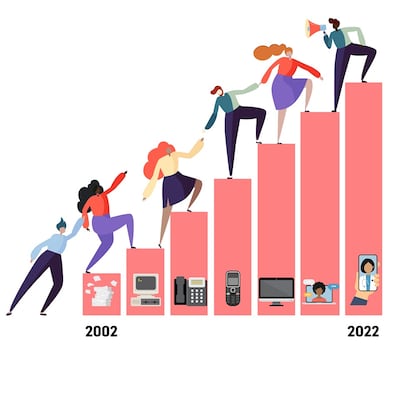Great Place to Work Ireland is delighted to announce the 2022 Best Workplaces for Women. Taking the global standard Best Workplaces methodology as its basis, the Best Workplaces for Women recognises those top organisations which, while providing a great work environment for all employees, are creating positive and supportive workplaces for women in particular.

Great Place to Work magazine looks at the changes that have happened in the workplace over the last 20 years since the Great Place to Work Institute was established in Ireland.
[ The Irish Times ePaperOpens in new window ]
These organisations develop and promote practices that make sure women in the workplace have a fair and positive work experience, and have the opportunity to contribute their talents and develop personally and professionally. They strive to bring balance to the interview process; create networks for women to connect, inspire, mentor, and challenge each other; have development programmes that foster a strong pipeline of female talent; offer flexible working packages that employees can adapt to best suit their needs; and much more.
This is our fourth year recognising the Best Workplaces for Women in Ireland, and we are delighted to see a diverse range of industries included this year, from pharmaceutical, technology and recruitment, to retail, manufacturing and tourism. The data we have gathered from these organisations represent tens of thousands of people and include the lived experiences of more than 1,300 female leaders.
Impact of Covid-19
Although the Covid-19 pandemic affected the workforce as a whole, it had a disproportionate impact on women. Living through a pandemic created so many unknowns, but also forced us to be more empathetic and adapt how we work and lead every day for better. We’re seeing success in a distributed workforce model gaining access to a global talent pool, creation of more flexible benefits to support individual needs, adoption of family-friendly policies and different working styles, and greater investment in connectedness among teams.
When we look at the Best Workplaces for Women, 90 per cent of women in these organisations feel able to take time off work when they think it is necessary and 84 per cent feel empowered to balance their work and personal life. Work-life balance, or fit, continues to be a challenge. The best organisations in this space, whether they are calling their employees back to the office, offering a hybrid work model, or allowing remote work across the board, have taken time to consider how their approach affects the women in their organisation. They have reviewed their work model with the women in their organisations – lower-level and senior-level women alike – gathering their feedback on how it can be improved or flexed to leave space for different scenarios to meet people where they are.
The space for conversation
These organisations are also creating the space for a wide range of conversations to happen. In fact, 93 per cent of women in these organisations feel that they are treated fairly, regardless of their gender. Every stage of the female experience in life, which previously have been very taboo in the workplace, is now being openly addressed and accommodated for in terms of workplace expectations.
For instance, while maternal and general wellbeing are now well established as ongoing conversations within most organisations, it appears that conversations around menopause are only beginning to emerge. The intricacies and person-specific symptoms of menopause make it hard for businesses to develop a one-size-fits-all approach to the issue, but one thing every organisation can do is open up dialogue.
Be what you see, and more
It is well established that being visible at work allows people to demonstrate their skills, land prominent assignments and build strategic relationships. It is worth noting that visibility is an increasingly complex topic with new and fluid working models – however, it is crucial for women at every level within an organisation.
This year’s Best Workplaces for Women are intentional about the visibility of their female leaders. Role models matter. They represent and expand what is possible, inspire women to be more ambitious and demonstrate the mindsets and behaviours of how to rise. Organisations also need to think about having a diversity of role models, with different styles, stories, personalities and perspectives.
More women in leadership and across organisations have visible personal brands. Telling their story is a critical factor in humanising the journey they have taken in their careers. This allows people in their organisation, or on their team, or aspiring leaders to see how they can grow, learn and help others. For example, stories of women who’ve approached their career as a matrix rather than a ladder have helped younger women think more laterally as they navigate their own career path.
Tapping into talent
Aside from the impact of Covid-19, people continue to leave their organisations for the same core reasons we saw in the pre-pandemic environment: they don’t feel valued by their organisation, they don’t feel valued by their managers, or they don’t feel a sense of belonging at work. People have had the time to reflect and prioritise, and given the tightness of the labour market, the power lands in the hands of talent.
Organisations that are intentionally building high-trust relationships and focus on connection in their company culture are better able to both retain and grow thriving teams. That has become a top priority for many organisations over the past year and will continue to increase throughout 2022 and beyond. Understanding the impact of Covid-19, creating the space for conversations and actively encouraging role modelling gives a chance for more voices and styles to build, brand and deliver the next generation of organisations and their cultures.












